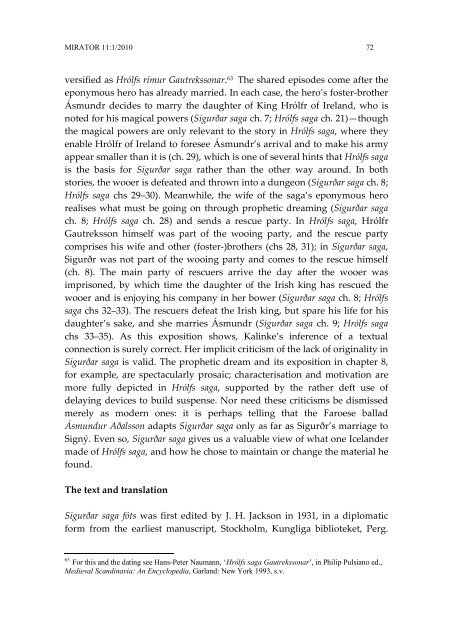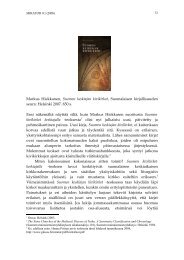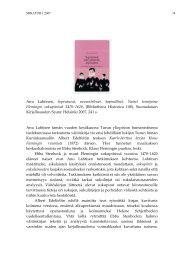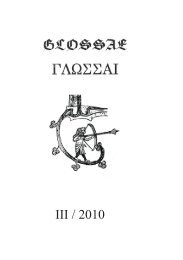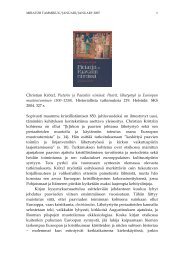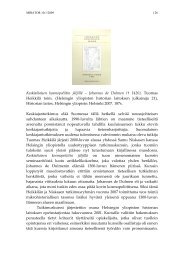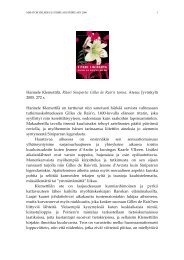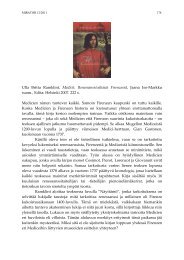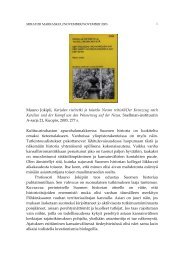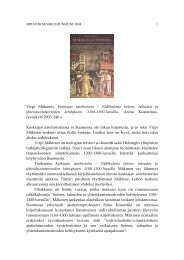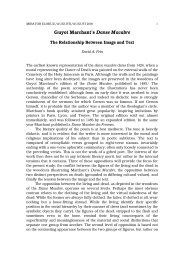Sigurðar saga fóts (The Saga of Sigurðr Foot)
Sigurðar saga fóts (The Saga of Sigurðr Foot)
Sigurðar saga fóts (The Saga of Sigurðr Foot)
Create successful ePaper yourself
Turn your PDF publications into a flip-book with our unique Google optimized e-Paper software.
MIRATOR 11:1/2010 72versified as Hrólfs rímur Gautrekssonar. 63 <strong>The</strong> shared episodes come after theeponymous hero has already married. In each case, the hero’s foster-brotherÁsmundr decides to marry the daughter <strong>of</strong> King Hrólfr <strong>of</strong> Ireland, who isnoted for his magical powers (<strong>Sigurðar</strong> <strong>saga</strong> ch. 7; Hrólfs <strong>saga</strong> ch. 21)—thoughthe magical powers are only relevant to the story in Hrólfs <strong>saga</strong>, where theyenable Hrólfr <strong>of</strong> Ireland to foresee Ásmundr’s arrival and to make his armyappear smaller than it is (ch. 29), which is one <strong>of</strong> several hints that Hrólfs <strong>saga</strong>is the basis for <strong>Sigurðar</strong> <strong>saga</strong> rather than the other way around. In bothstories, the wooer is defeated and thrown into a dungeon (<strong>Sigurðar</strong> <strong>saga</strong> ch. 8;Hrólfs <strong>saga</strong> chs 29–30). Meanwhile, the wife <strong>of</strong> the <strong>saga</strong>’s eponymous herorealises what must be going on through prophetic dreaming (<strong>Sigurðar</strong> <strong>saga</strong>ch. 8; Hrólfs <strong>saga</strong> ch. 28) and sends a rescue party. In Hrólfs <strong>saga</strong>, HrólfrGautreksson himself was part <strong>of</strong> the wooing party, and the rescue partycomprises his wife and other (foster-)brothers (chs 28, 31); in <strong>Sigurðar</strong> <strong>saga</strong>,<strong>Sigurðr</strong> was not part <strong>of</strong> the wooing party and comes to the rescue himself(ch. 8). <strong>The</strong> main party <strong>of</strong> rescuers arrive the day after the wooer wasimprisoned, by which time the daughter <strong>of</strong> the Irish king has rescued thewooer and is enjoying his company in her bower (<strong>Sigurðar</strong> <strong>saga</strong> ch. 8; Hrólfs<strong>saga</strong> chs 32–33). <strong>The</strong> rescuers defeat the Irish king, but spare his life for hisdaughter’s sake, and she marries Ásmundr (<strong>Sigurðar</strong> <strong>saga</strong> ch. 9; Hrólfs <strong>saga</strong>chs 33–35). As this exposition shows, Kalinke’s inference <strong>of</strong> a textualconnection is surely correct. Her implicit criticism <strong>of</strong> the lack <strong>of</strong> originality in<strong>Sigurðar</strong> <strong>saga</strong> is valid. <strong>The</strong> prophetic dream and its exposition in chapter 8,for example, are spectacularly prosaic; characterisation and motivation aremore fully depicted in Hrólfs <strong>saga</strong>, supported by the rather deft use <strong>of</strong>delaying devices to build suspense. Nor need these criticisms be dismissedmerely as modern ones: it is perhaps telling that the Faroese balladÁsmundur Aðalsson adapts <strong>Sigurðar</strong> <strong>saga</strong> only as far as <strong>Sigurðr</strong>’s marriage toSigný. Even so, <strong>Sigurðar</strong> <strong>saga</strong> gives us a valuable view <strong>of</strong> what one Icelandermade <strong>of</strong> Hrólfs <strong>saga</strong>, and how he chose to maintain or change the material hefound.<strong>The</strong> text and translation<strong>Sigurðar</strong> <strong>saga</strong> <strong>fóts</strong> was first edited by J. H. Jackson in 1931, in a diplomaticform from the earliest manuscript, Stockholm, Kungliga biblioteket, Perg.63For this and the dating see Hans-Peter Naumann, ‘Hrólfs <strong>saga</strong> Gautrekssonar’, in Philip Pulsiano ed.,Medieval Scandinavia: An Encyclopedia, Garland: New York 1993, s.v.


